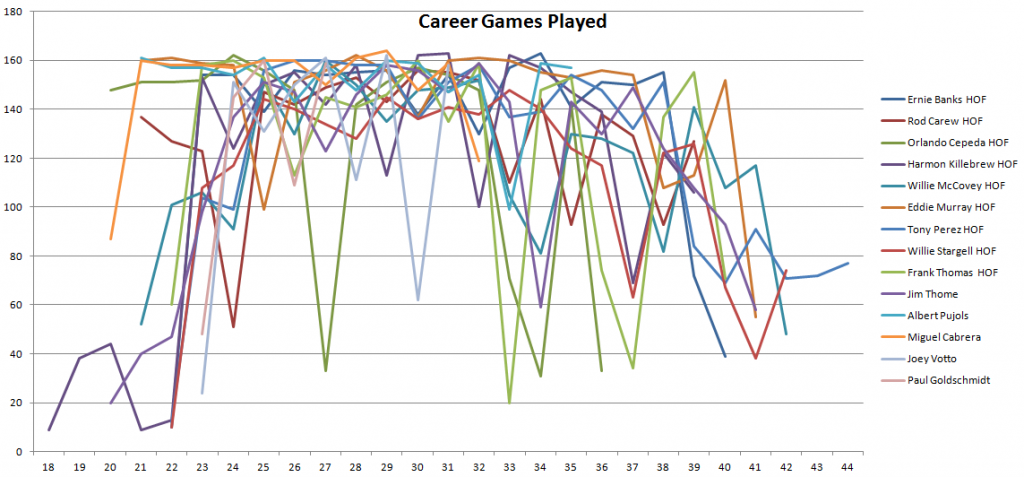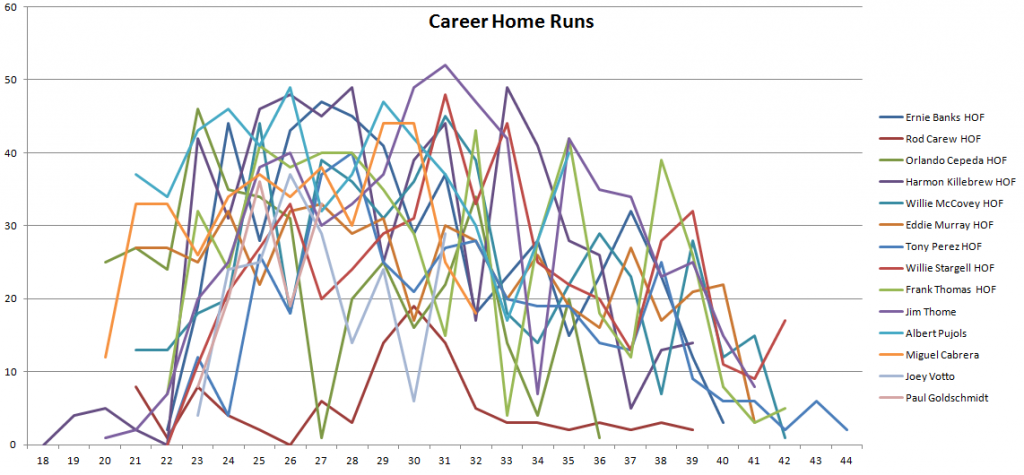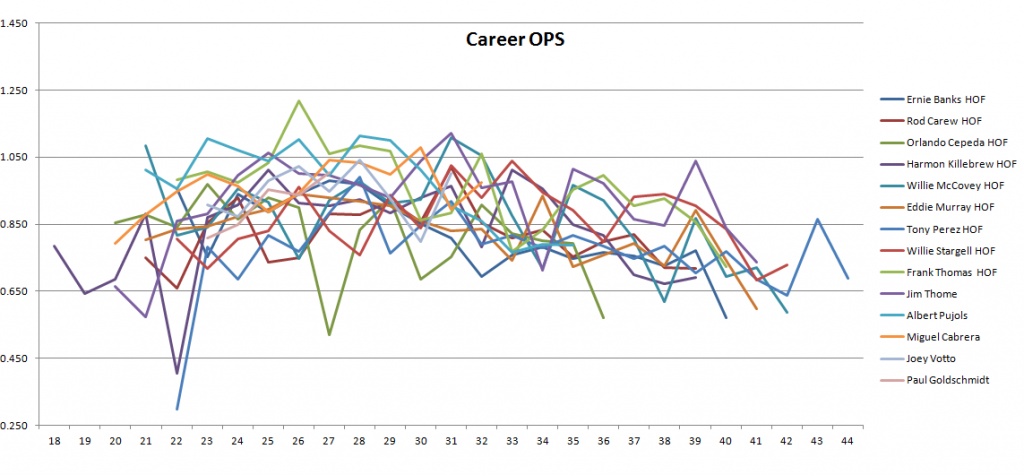Double Plus: Goldschmidt vs. HOF First Basemen
Yesterday I wrote a lot about Paul Goldschmidt as a possible Hall of Fame candidate. If you didn’t read the full installment, I’d suggest going back and taking a gander. Today things won’t be so long and exhaustive. Let’s keep it short because that’s what Double Plus Fridays are all about anyways (at least in theory).
I decided to look at some key indicators (games played, home runs and OPS) for Goldschmidt and plot his progress against three groups:
- Nine Hall of Fame first basemen who started their career no earlier than 1950
- A near lock for the Hall of Fame once added to the ballot now that he’s retired
- Three very good first basemen playing right now who have a chance for The Hall
Rather than looking at averages and totals like we did yesterday, however, I wanted to see progress through each season of a player’s career. That makes for some rather busy graphs, and for that I apologize. You may try clicking on them so they’re enlarged and you can peruse more easily.
Games Played
There are a couple of takeaways from this first graph. First and foremost, the bulk of these players kept their careers going until at least 40. That requires prolonged health and effectiveness. Second, no player lost an entire season (to injury or some other cause) and many did not ever miss a major portion of any season that they played. When you’re trying to accumulate stats and awards, this is very helpful. Goldy didn’t start his big league career until he was 23-years old. No player from this group started his career later than 22. That’s not say Goldschmidt is precluded from joining, but it does put some pressure on him to, at the very least, stay on the field. The final observation is an obvious one – as players age, they play fewer games, putting the pressure on their mid-20’s through mid-30’s.
Home Runs
The volatility is heightened here. Importantly, not every player has to be Jim Thome or Harmon Killebrew. But most players’ peaks include nearly a decade near or beyond 30 long balls per season. Goldy has two to his credit right now and he’ll surely need to keep it going until his mid-30’s before things start to really taper off as they have for every player listed.
OPS (On-Base plus Slugging)
I’m not the biggest proponent of OPS because we can do better, but it was readily available so we’ll use for now. As a demonstration of performance irrespective of games played, it does a decent job of capturing the drop in performance of these players as they age. There are usually about eight good years in there where players post an OPS of .900+ before the decline starts to set in. That said, these players didn’t exactly fall off a cliff – it was a nice, slow decline. Still, the window to really amass counting stats is essentially 25-33-years old for most. If you can extend that like Orlando Cepeda did, well, good for you.
Comparable Players
Dan Szymborski releases his ZiPS projections every year, and recently did so for the 2016 Arizona Diamondbacks. He was also kind enough to share Paul Goldschmidt’s 25 most comparable players through his age-27 season. Of those 25, there are some notable names included:
- Jeff Bagwell is Goldy’s top comp and there’s still plenty of reason to believe Bags will get in to the Hall of Fame
- Edgar Martinez is a comp for Goldschmidt and may or may not get in (but should)
- Manny Ramirez is up for consideration next year and is also a strong possibility for enshrinement
- Similarly, Jim Thome shows up as a comparison and is likely to get in
- Eddie Murray, Cepeda and Dave Winfield are all current Hall of Famers who Goldschmidt is comped to
These are the most notable comps but there are others. Todd Helton, Albert Pujols, Tim Salmon, Matt Holliday, Gil Hodges, Chet Lemon, Danny Tartabull, you get the idea. Each of these players was or is very good. In the past, Ryan discussed why Paul Goldschmidt might age especially well and, like most Hall of Fame players, he’ll certainly need to. Even as all of the above Hall of Famers declined to some degree, they generally did so at a less alarming rate than the average player.
All of this is to say that Paul Goldschmidt needs to keep being good and do so for a long time. You probably knew that. But so far so good. It’s just that there’s still so far to go. We’ll know more in three years or so. As long as he keeps up the pace, the Diamondbacks will be in good shape.
Recent Posts
@ryanpmorrison
 Congrats to @OutfieldGrass24 on a beautiful life, wedding and wife. He deserves all of it (they both do). And I cou… https://t.co/JzJtQ7TgdJ, Jul 23
Congrats to @OutfieldGrass24 on a beautiful life, wedding and wife. He deserves all of it (they both do). And I cou… https://t.co/JzJtQ7TgdJ, Jul 23 Best part of Peralta’s 108 mph fliner over the fence, IMHO: that he got that much leverage despite scooping it out… https://t.co/ivBrl76adF, Apr 08
Best part of Peralta’s 108 mph fliner over the fence, IMHO: that he got that much leverage despite scooping it out… https://t.co/ivBrl76adF, Apr 08 RT @OutfieldGrass24: If you're bored of watching Patrick Corbin get dudes out, you can check out my latest for @TheAthleticAZ. https://t.co/k1DymgY7zO, Apr 04
RT @OutfieldGrass24: If you're bored of watching Patrick Corbin get dudes out, you can check out my latest for @TheAthleticAZ. https://t.co/k1DymgY7zO, Apr 04 Of course, they may have overtaken the league lead for outs on the bases just now, also...
But in 2017, Arizona ha… https://t.co/38MBrr2D4b, Apr 04
Of course, they may have overtaken the league lead for outs on the bases just now, also...
But in 2017, Arizona ha… https://t.co/38MBrr2D4b, Apr 04 Prior to the games today, there had only been 5 steals of 3rd this season (and no CS) in the National League. The… https://t.co/gVVL84vPQ5, Apr 04
Prior to the games today, there had only been 5 steals of 3rd this season (and no CS) in the National League. The… https://t.co/gVVL84vPQ5, Apr 04
Powered by: Web Designers@outfieldgrass24
 Today, I lost a large fish. The kind most of us get a chance at only once or twice a season. Here’s me losing him i… https://t.co/oEzcmENIyh, Mar 15
Today, I lost a large fish. The kind most of us get a chance at only once or twice a season. Here’s me losing him i… https://t.co/oEzcmENIyh, Mar 15 #GoBeavs, Mar 14
#GoBeavs, Mar 14 RT @C70: For your afternoon reading, a little #DBacks talk with @OutfieldGrass24 and @AZSnakepit! #PlayingPepper https://t.co/QOY0pKSHzx, Mar 10
RT @C70: For your afternoon reading, a little #DBacks talk with @OutfieldGrass24 and @AZSnakepit! #PlayingPepper https://t.co/QOY0pKSHzx, Mar 10 RT @cdgoldstein: "Nothing bums me out more than writing about the Angels. It’s an instant shot of ennui. If I wanted to watch a prom… https://t.co/kBPn2t7qWA, Mar 10
RT @cdgoldstein: "Nothing bums me out more than writing about the Angels. It’s an instant shot of ennui. If I wanted to watch a prom… https://t.co/kBPn2t7qWA, Mar 10 RT @wildfishNW: Right now WA is deciding whether to legalize fish traps in the Columbia R! We need your help to ensure commercial f… https://t.co/tKJhnUHNEs, Mar 09
RT @wildfishNW: Right now WA is deciding whether to legalize fish traps in the Columbia R! We need your help to ensure commercial f… https://t.co/tKJhnUHNEs, Mar 09
Powered by: Web Designers







